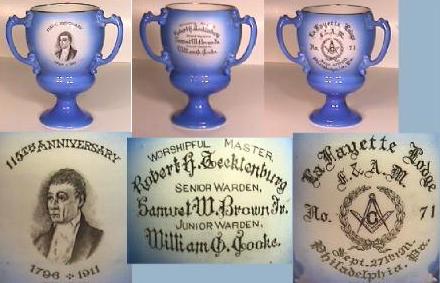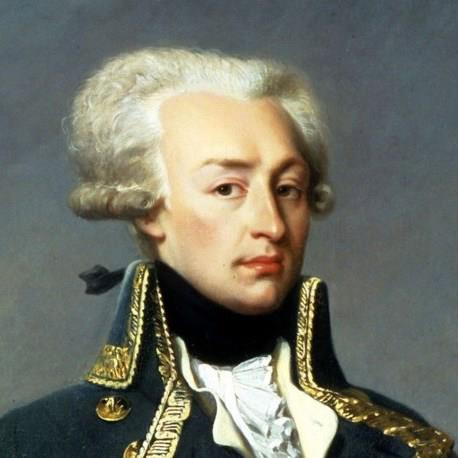Lafayette
Lodge No. 71 F. & A.M.
Three Handled
Loving Cup


This beautiful Three Handled
Loving Cup commemorates the 115th Anniversary (1796-1911) of Lafayette Lodge
No. 71 of Philadelphia. Pa. on September 27th, 1911. One side panel
depicts a portrait of the famous General and it also names the three principle
officers of the Lodge on another panel. It is decorated in a pretty
cobalt blue with black transfers and stands 7 1/4 inches tall.
The
Ceremony of the Loving Cup
An Ancient Masonic Ceremony of Sharing
Author
Unknown
This is an old tradition in Wellington Lodge No. 1385 usually performed at the
conclusion of a banquet. It is a very old custom which seems to have almost
died out, at least in Craft Masonry. Wellington tries to maintain this
tradition and is famous for it.
Actually the Loving Cup should be passed after the Entered Apprentice song has
been sung. This is a ceremony handed down through the ages and need not be
limited to initiations, which Wellington does not do.
The procedure was for three Brethren to stand, two would unsheath their swords
and the third (middle) to hold up the cup by the two handles and to drink
whilst the two others defended him, one facing him and the other with his back
to the drinker’s back. Having taking his draught, the drinker then wipes the
cup with a napkin. The two brethren with thier backs together then turn to
face each other and the cup is handed over. The next brother in the line now
stands to protect the back of the drinker, and so on.
A later variation of the Loving Cup for toasting is the large two handled
wassail bowl or cup, usually pewter or silver and sometimes bearing the Lodge
badge or crest. At the festive Board it is passed round from Brother to
Brother around the table. The word “wassail” comes from the old English “Waes
Hail”, meaning “Be thou whole and of good health”. The custom of protection of
the drinker’s back is said to date back to Saxon times, when a man might be
treacherously stabbed whilst drinking - hence a friend or two defend him with
drawn swords. This may be borne out by the murder, in A.D. 979 of King Edward
(later known as Edward the Martyr), when he was so stabbed on the orders of
his stepmother, Elfrida, so that her own son, Ethelred could become King
instead. He was stabbed at the feast while drinking mead from a two handled
loving cup by a paid assassin.
There are many forms of the ceremony but the process of sharing, coupled with
mutual protection is the same — it reinforces the ancient Masonic bond we have
with each other.


Masonic
History of Lafayette
The
following is from the book "10,000 Famous Freemasons" By William R.
Denslow, Vol. III, K
- P,"L"
page 45, 46. This
book printed by the Macoy Publishing & Masonic Supply Co. Inc. Richmond,
Virginia. (4 book boxed set, Vol. I, II, III, IV.)
Marquis
de Lafayette (1757-1834)
French
statesman and officer; hero of the American Revolution. His name in full
was Marie Joseph Paul Yves Roch Gilbert de Motier. b. Sept. 6, 1757 in the
family castle "Chavaniac" at Auvergne, France. His father, a
soldier, had died at the Battle of Minden a few weeks before his birth, and
his mother died in 1770, leaving him a vast estate. He refused a
prominent position in the French court to become a soldier in 1771. He
withdrew from the service in 1776, outfitted his own ship, Victoire, and
sailed with 15 other young adventurers, including Baron de Kalb, to fight with
the American colonists against England. At first their services were
refused by Congress, but noting Lafayette's full pocketbook, connections at
the French court, and his offer to serve without pay, he was commissioned a Major
General in the Continental Army on July 31, 1777. He became an intimate
associate of Washington. At Brandywine he was severely wounded while
rallying the American forces from a retreat. He was appointed to lead an
expedition to invade Canada, but the plan was never carried out, for lack of
funds. He was with Washington at Valley Forge; served on the court martial
that tried Major Andre; stationed at Tappan, N.Y.; served in Virginia; and was
at the Battle of Yorktown and the surrender of Cornwallis. In 1778-80 he
was on furlough in France to assist Franklin in obtaining financial aid from
France for the colonists. Lafayette returned to France in Dec. 1781,
almost as soon as the war had been won. He was now the hero of two
nations, both America and France. He became a member of the French national
assembly in 1789, where he showed his liberal sympathies. He was
instrumental in bringing about the adoption of the present French tri-colored
flag, and a founder of the Club of the Feuillants, the conservative liberals
who sought to establish a constitutional monarchy in 1780. He commanded
an army in the war with Austria, but when he opposed further advance of the
Jacobites, he was declared a traitor by the national assembly. He fled
to Flanders and was imprisoned by the Austrians from 1792-97. His flight
probably saved his life as his compatriots were executed during his
imprisonment. He returned to France in 1799, but took no part in
politics, being opposed to Napoleon's policies. He was a member of the
chamber of deputies in 1815, 1818-24, and a leader of the opposition from
1825-30. He commanded the national guard in the revolution of
1830. He returned to America for his first visit of five months in
1784. It was on this visit that he presented Washington the Masonic
Apron made by Madame Lafayette. It is now in the possession of the Grand
Lodge of Pa. He returned again in 1824-25, at the invitation of a
grateful congress, which had voted him $200,000. This time he toured all
the 25 states and received more Masonic honors than any Freemason before or
since. From Maine to Georgia, and Missouri to Louisiana, lodges,
chapters, councils, commanderies, scottish rite and grand lodges vied with
each other in conferring honorary degrees, citations, gifts and
memberships. Strangely enough, it is not known where or when he received
his degrees. Some say it was in an army lodge in Morristown, N.J.
Others feel it was in the winter of 1777 at Valley Forge. In addressing
the Grand Lodge of Tennessee on May 4, 1825, Lafayette, himself, stated that
he was initiated before he ever came to America. He would have been under 21,
but at that time "Lewis" Masons (under age) were being raised in
France. A Spanish Masonic history states that he was a member of Loge La
Candeur of Paris, founded in 1775. A French Masonic history says his
name is among the lists of members of Loge Contrat Social of Paris between the
years 1773 and 1791. He received the chapter degrees in Jerusalem
Chapter No. 8, R.A.M., New York City, Sept. 12, 1824. His son, George
Washington Lafayette, received them in the same chapter four days
earlier. He was bian Commandery No. I of N.Y.C. He received the
Scottish Rite degrees in the Cerneau Supreme Council of N.Y., and was made 33'
and honorary grand commander of that body. The Supreme Council of France
AASR elected him a member, Nov. 21, 1830. More than 75 Masonic bodies in
the U.S. have been named after him, including 39 Lodges, 18 Chapters, 4 Councils,
4 Commanderies, and 7 Scottish Rite bodies. d. May 20, 1834.
A
special "Thanks" to Brother Jerry Stotler (jstot on eBay) for
providing the pictures and descriptions of this wonderful Loving Cup.

